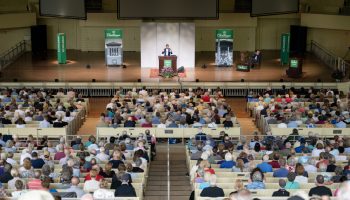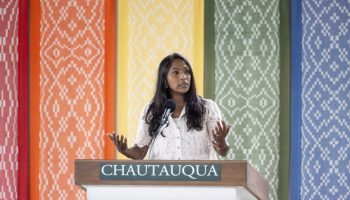What is Chautauqua?
When people who have never visited this singular community ask that question, those who have experienced Chautauqua Institution for a week or a season or even a lifetime are often hard-pressed to answer.
Jon Schmitz, the Institution’s historian and archivist for the past 15 years, has a pretty good idea of what Chautauqua is, and at 3:30 p.m. Friday in the Hall of Christ, he will share his considerable knowledge in “ChautauqWhat? An Overview of Chautauqua’s History,” as part of the Oliver Archives Heritage Lecture Series. Afterward, he will take questions from the audience.
“If there is one thing you can say about Chautauqua, it is that there is no one thing to say about Chautauqua,” Schmitz said.
Likening his task to the story of the blind men and the elephant, Schmitz reflects on the observations of the famous and forgotten over the years, almost all of whom used the adjective “American” in their descriptions.
Founded in 1874 by the Methodist clergyman John Heyl Vincent and Lewis Miller, an industrialist and philanthropist, Chautauqua ostensibly began as a summer retreat for Sunday school teachers. But, from the start, it entailed much more. Each day at the nascent assembly was treated as a Sabbath day, a time to worship, rest, reflect and learn. Americans had a lot to reflect upon following the national calamity of the Civil War, and they had more leisure time than ever before to broaden their religious, educational and cultural experiences.
According to Schmitz, Chautauqua combined elements of three 19th-century institutions: the camp meeting, the lyceum and the Sunday school. Camp meetings served as a way for people, particularly on the frontier, to come together for religious services and to share social and political ideas. The lyceum movement, which began in England, provided lectures, classes and books to people in far-flung locations. The Sunday school, especially the Methodist idea of it, went well beyond theology to teach children reading, writing, arithmetic and manners during the one day they were not expected to work.
From the camp meeting, Vincent and Miller took the concept of a venue that could be returned to year after year, Schmitz said. From the lyceum, they adopted the idea of using leisure time for lifelong learning and self improvement. From Sunday school, they drew the power to enlighten. Combined, Schmitz said, that became the Chautauqua idea.
The logistics and mechanics of building a community around that idea were put in place early, and have remained very much the same ever since, Schmitz said. The beauty of the lake and advances in transportation drew people to the assembly at what was then called Fair Point. Gates were built and admission charged through a gate pass. Tents went up, followed by cottages. Dining and lecture halls sprouted. Bells signaled the time to wake up, to gather and to go to bed. A scale model of the Holy Land to facilitate religious instruction was built on the shore of the lake, where it remains nearly 150 years later. Morning worship was followed by classes and lectures, which in turn were followed by recreational activities such as sailing, rowing and croquet. In the evenings, there were concerts, lantern-slide shows and more speakers. All of those, in one form or another, continue to this day.
“This formula for a mix of education, edification and entertainment would define what Chautauqua was to be and would in time remake modern American culture,” Schmitz said.
More than 20,000 people attended that first summer assembly. And people came back, year after year, building summer homes for their families that give the grounds its distinctive cozy atmosphere. What attracted these people, then as now, Schmitz said, was the model of how to use leisure time well.
“It has been the great struggle of mankind to achieve more leisure,” President James A. Garfield once said. “It was left to Chautauqua to tell us how to use it.”
Vincent believed that good use of leisure time went well beyond the summer season. He and Miller created a correspondence reading course that allowed people who could not attend college because they were too poor, too busy or too remote to gain the equivalent of a college education through reading in their spare time. The course, called the Chautauqua Literary and Scientific Circle, was created in 1878 and is still going strong. Hundreds of thousands have completed the course.
Chautauqua had its ups and downs through the decades, and at one point faced financial ruin, Schmitz said. But it survived and thrived, even as almost all of the many “daughter Chautauquas” that emerged in imitation of its model faded through the 20th century.
“The most surprising thing to me about Chautauqua is that it still exists. Its continuing relevance rests on its addressing needs that are not being met, needs for community and shared experience,” Schmitz said. “It’s not so much that it is uniquely American, it’s that it is essentially American.”





